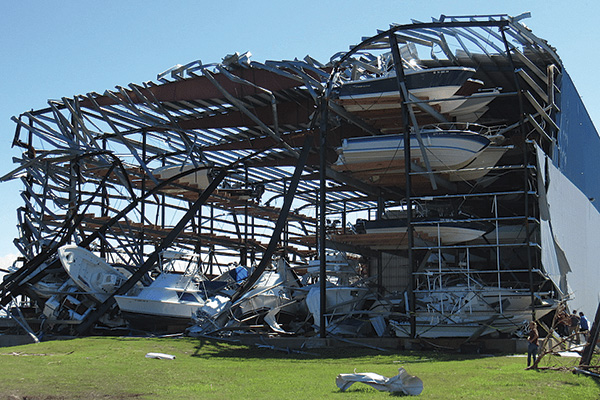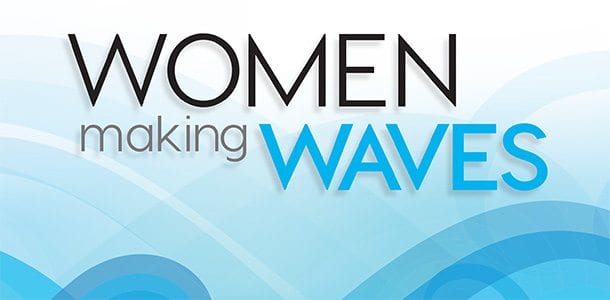Hurricane hole: Marina safety & preparedness

By David Gee
The word hurricane is derived from “juracán,” which according to Taíno natives in the Caribbean and Central America, were storms spawned and controlled by the goddess Guabancex, also known as the “one whose fury destroys everything.”
The scientific name for a hurricane is tropical cyclone. In general, a cyclone is a large system of spinning air that rotates around a point of low pressure. Only tropical cyclones, which have warm air at their center, become the powerful storms that are called hurricanes.
“Successful preparation for a hurricane depends on how early and how orderly we act,” according to Hurricane Preparedness Guidelines published by the U.S. Federal Emergency Management Agency, or FEMA. “Boat owners and marina operators all along the coast should consider hurricane preparation part of normal boat and marina maintenance. Just a few unprepared boats can inflict incredible damage on a marina, as can unsecured facilities and equipment. Marina managers must begin early in developing a formal written plan.”
Are you – and your marina, boatyard, and/or boat – prepared? That’s one question. The next question is prepared for what?
The science

Globally, about 70 to 110 tropical storms form each year, with about 40 to 60 reaching hurricane strength.
Although scientists are uncertain whether climate change is leading to an increase in the number of hurricanes, warmer ocean temperatures and higher sea levels are expected to intensify their impacts.
The Geophysical Fluid Dynamics Laboratory, or GFDL, conducts comprehensive long-lead-time research into the behavior of the atmosphere, oceans, land, and ice components and their interactions with the ecosystem.
Their models project a 45%–87% increase in the frequency of Category 4 and 5 hurricanes.
Due to warmer sea surface temperatures, their scientists also expect a 2%-11% increase in average maximum wind speed of future hurricanes.
Warmer seas also mean more precipitation. Rainfall rates during these storms are projected to increase by about 20% and, as recent hurricanes such as Harvey have shown, this can sometimes be the more destructive impact.
The GFDL says sea level rise is likely to make future coastal storms, including hurricanes, more damaging. Globally averaged, sea level is expected to rise by one to four feet during the next century, which will amplify coastal storm surge.
Destructive forces at work
Preparing a boat, or a marina, for a hurricane means fighting a battle against wind, rain, waves, and high water, all in extraordinary measures.
Wind – To be classified as a hurricane, a tropical cyclone must have one-minute maximum sustained winds of at least 74 mph (Category 1). The highest classification in the scale, Category 5, consists of storms with sustained winds over 156 mph. The classifications can provide some indication of the potential damage and flooding a hurricane will cause upon landfall. Hurricane Camille, in 1969, had the highest wind speed at landfall ever recorded worldwide, at an estimated 190 miles per hour when it struck the Mississippi coast.
Rainfall – The average storm total rainfall for a tropical cyclone impacting the lower 48 from the Atlantic basin is about 16 inches, with 70%–75% of the storm total falling within a 24-hour period.
However, Hurricane Harvey in 2017 brought the greatest rainfall event ever recorded in the U.S. by a tropical cyclone—an astonishing 60.58 inches to parts of Texas.
Waves – The barometric pressure in the eye of a hurricane is lower than the pressure some distance from the eye, throughout the rest of the storm body. High wind speeds associated with hurricanes are able to produce extreme waves. Waves nearly 100 feet tall were recorded in the Gulf of Mexico when Hurricane Ivan headed toward shore. Even inland, coastal waves of up to 30 feet and more have been observed during hurricanes such as Sandy.
Surge – This is water from the ocean that is pushed toward the shore by the force of the winds swirling around the hurricane. This advancing surge combines with the normal tides and can increase the water level by 30 feet or more. The massive mound of water that builds up and comes ashore during a hurricane, is often the deadliest and most destructive threat from the storms. Storm surge has accounted for about half of the deaths in hurricanes since 1970, according to the National Hurricane Center. It caused most of the 1,200 deaths in Hurricane Katrina in 2005.
To prepare

As FEMA states, every marina operator and boat owner should have a hurricane plan in place.
When the watches and warnings come, timing is critical.
Their guidebook suggests that “a marina hurricane preparedness plan needs to be specific. For example, your plan should include if/which dry rack boats will be tied down and define the amount of personnel and time required to do so. Describe necessary materials and equipment and their locations for the job. The plan also needs to be realistic. If you encourage (recommended) or require (not recommended) wet slip evacuation, suggest alternative locations that provide storm protection. If your plan recommends evacuation to a hurricane hole, boats and boat operators will be needed to bring people back (no one should stay aboard during a hurricane). Require each boat owner to submit hurricane readiness information at the beginning of the season. The boat owner may not be available at the time of a storm, so an alternate caretaker should be named.”
They add that to successfully implement a hurricane plan someone must be in charge – a decision-maker to set the plan in motion and deal with contingencies. FEMA recommends this person be familiar with weather service warnings and storm tracks.
The National Oceanic and Atmospheric Administration says a hurricane warning indicates that hurricane conditions (sustained winds of 74 mph or higher) are expected somewhere within the specified area. Because hurricane preparedness activities become difficult once winds reach tropical storm force (sustained winds of 39 to 73 mph), the hurricane warning is issued 36 hours in advance of the anticipated onset of tropical-storm-force winds to allow for important preparation.
A hurricane watch means that hurricane conditions (sustained winds of 74 mph or higher) are possible within the specified area. A hurricane watch is issued 48 hours in advance of the anticipated onset of tropical-storm-force winds in an area.
During this time, there needs to be constant communication between the marina and boat owners, through email blasts, Facebook, Twitter and text.
FEMA says all boats, docks, buildings, and equipment must be secured by the time a hurricane WARNING is issued. Remember that agency timetables refer to landfall of the hurricane EYE–severe weather can significantly precede the eye.
Duties should be delineated in early planning. However, be prepared to make changes depending on storm characteristics, including the probability of a direct hit and the expected intensity of the storm.
The good news is that hurricanes offer a unique advantage over many other forms of natural disasters in that they are visible and can be tracked many days in advance of their arrival.
The bad news is that minor variations in the predicted path, or variations in the predicted intensity, can result in huge changes when they actually arrive.
But with planning, preparation, timely action and maybe a little bit of luck, your marina, boatyard and/or boat can escape the destructive force of a hurricane that some call “the greatest storm on Earth.”
FEMA recommends during the hurricane pre-season, or off-season, to review the marina Hurricane Preparedness Plan and update or revise it as necessary.
Marina Manager
Reassess marina emergency procedures policy.
Review rental agreements to ensure clarity of renter liability for property damage and personal injury.
Specify that vessel owners will be billed for services and materials necessary for preparation, response, and recovery.
Contact the County Emergency Management Director each spring to review: overall disaster plan, emergency assistance communications, wet slips evacuation concerns, considering such factors as severe weather drawbridge policy, boat evacuation routes, safe harbors, etc.
Review and update the detailed map of the marina showing locations of utility equipment and power shutoff points, sources of auxiliary power, potential hazard areas such as from fallen objects, trees, poles, etc., emergency equipment and supplies, communication equipment, first aid stations and escape routes.
Identify items for evacuation in each department of the marina (department managers to develop check lists).
Remind boat owners of responsibilities during hurricane season (send detailed letter prior to June 1).
Hold Hurricane Preparedness Plan training to include personal and family safety for marina personnel and volunteers.
Supervise /inspect all areas of the marina for pre-hurricane season safety, housekeeping, repair and maintenance. Correct problems immediately! (Suggest developing an inspection checklist).
Verify with insurance agent that marina is adequately insured, particularly for wind and water damage. Keep current photos of marina facilities on file and ensure that any applicable specifications required by the insurance policy (the fine print) have been met. Have this confirmed in writing.
Review listings for repair and salvage companies. Pre-qualify companies with references, proof of insurance, performance bonds and releases.
Hurricane Response Team
Review Hurricane Preparedness Plan (as revised for current year).
Assist marina manager with marina housekeeping, repair, and maintenance inspection program.
Update hurricane contact lists and distribute among marina employees, wet slip and dry rack customers.
Communications Coordinator
Organize and train a communications team. Include the marina manager on this team. Be aware that communication is the key element in successfully carrying out the Hurricane Preparedness Plan. The communications team has the responsibility to make equipment available and to make certain that communication takes place between marina management, the various marina departments and boat owners.
Devise a communication system with boat owners, including name, address, and telephone number of designated caretaker in the event they are out of town during hurricane season.
Update employee emergency contact list. Post and maintain a phone number list to include: Emergency Management Agency, insurance agent, pre-qualified repair and salvage companies, utility companies, fire department, police and Marine Patrol, rescue service, hospital, and employees Inventory marina handheld radios and weather alert radios.




